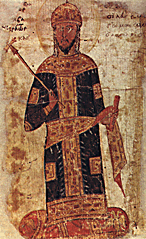 |
|
 |
Philosophy
 Philosophy, in the Late Byzantine period, offers no original concept.
Philosophy, in the Late Byzantine period, offers no original concept.
 However, many works produced at the time bear the mark of the intellectual movements of
humanism
and the Palaiologan Renaissance. Their authors sought a system of philosophical thought, and aimed at the dissemination and assimilation of ancient Greek philosophy. Although essentially opposed to each other to the end, as the hesychast conflict showed, nonetheless the Byzantine philosophers elaborated classical philosophical thought, to which they gave a novel interpretation, combining it with the teachings of the Fathers of the Church. They transcribed the works of Aristotle and interpreted them in an original manner. In fact, towards the end of this period, a lively scholarly debate took place, However, many works produced at the time bear the mark of the intellectual movements of
humanism
and the Palaiologan Renaissance. Their authors sought a system of philosophical thought, and aimed at the dissemination and assimilation of ancient Greek philosophy. Although essentially opposed to each other to the end, as the hesychast conflict showed, nonetheless the Byzantine philosophers elaborated classical philosophical thought, to which they gave a novel interpretation, combining it with the teachings of the Fathers of the Church. They transcribed the works of Aristotle and interpreted them in an original manner. In fact, towards the end of this period, a lively scholarly debate took place,
 as to which of the two philosophical systems - the Platonic or the Aristotelian - was the superior. It is worth noting that, while at this time the influence of Byzantium on the West was quite strong, the Byzantines on the other hand remained impervious to Western mentality and
scholastic philosophy. as to which of the two philosophical systems - the Platonic or the Aristotelian - was the superior. It is worth noting that, while at this time the influence of Byzantium on the West was quite strong, the Byzantines on the other hand remained impervious to Western mentality and
scholastic philosophy.
The first scholar of the Late Byzantine period to deal with philosophical issues was
Nikephoros Blemmydes,
who wrote a manual on logic and physics, which was widely used in both the East and the West. He was followed by his most important disciple, the emperor
Theodore II Laskaris,
who wrote two books on philosophy: the Kosmike Delosis and Tes Physikes Koinonias Logoi Hexi. In the next period, George Pachymeres paraphrased the works of Aristotle, adding his own commentaries - as did the
 monk Sophonias -
in a work that was widely disseminated and was known as the "Philosophy of Pachymeres", while
Maximos Planoudes
produced a Greek translation of the works of
Boethius
and
Thomas Aquinas.
monk Sophonias -
in a work that was widely disseminated and was known as the "Philosophy of Pachymeres", while
Maximos Planoudes
produced a Greek translation of the works of
Boethius
and
Thomas Aquinas.
The most important contribution to philosophical thought, however, came from later writers, namely from such scholars as
Nikephoros Choumnos,
Theodore Metochites, Nikephoros Gregoras, George Gemistos or Plethon and George Gennadios Scholarios. Choumnos, in his nine philosophical works, wrote a critique on the philosophy of Plato, Aristotle and
Plotinus.
 Metochites, in his book Hypomnematismoi ("Annotations"), offered the most
extensive elaboration of the work of ancient philosophers, chiefly that of
Aristotle, with whose works he was thoroughly acquainted. The most outstanding among his disciples was Nikephoros Gregoras, who, because of his philosophical learning and his writings, was nicknamed "the philosopher". Most interesting is his philosophical attitude towards the hesychast controversy and the theological and philosophical issues it involved. As to the great George Gemistos Plethon, he is related to a whole School of Platonists at Mistra, and his famous work Peri on Aristoteles pros Platona diaferetai ("On
the Differences of Aristotle from Plato") which he wrote in Florence in 1439, was the spark which ignited the most serious conflict between Aristotelians and Platonists in Byzantium and Italy. He taught philosophy at Mistra and believed that the ideal state would be built on the Neoplatonic philosophical system and not on Christianity. He was thus the ideologic opponent of the last philosopher of this period, Patriarch Gennadios Scholarios, who, although he wrote an extensive commentary on Aristotle and a lesser one on Plotinus, did not hesitate to throw Plethon's book Nomon Syngraphe ("Book of Laws") into the fire with his own hands, after the latter's death.
Metochites, in his book Hypomnematismoi ("Annotations"), offered the most
extensive elaboration of the work of ancient philosophers, chiefly that of
Aristotle, with whose works he was thoroughly acquainted. The most outstanding among his disciples was Nikephoros Gregoras, who, because of his philosophical learning and his writings, was nicknamed "the philosopher". Most interesting is his philosophical attitude towards the hesychast controversy and the theological and philosophical issues it involved. As to the great George Gemistos Plethon, he is related to a whole School of Platonists at Mistra, and his famous work Peri on Aristoteles pros Platona diaferetai ("On
the Differences of Aristotle from Plato") which he wrote in Florence in 1439, was the spark which ignited the most serious conflict between Aristotelians and Platonists in Byzantium and Italy. He taught philosophy at Mistra and believed that the ideal state would be built on the Neoplatonic philosophical system and not on Christianity. He was thus the ideologic opponent of the last philosopher of this period, Patriarch Gennadios Scholarios, who, although he wrote an extensive commentary on Aristotle and a lesser one on Plotinus, did not hesitate to throw Plethon's book Nomon Syngraphe ("Book of Laws") into the fire with his own hands, after the latter's death.
See also: George Gemistos Plethon,
George Pachymeres,
Nikephoros Gregoras,
Theodore Metochites,
George Gennadios Scholarios,
Hesychasm
|